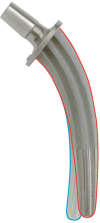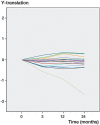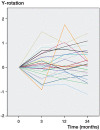A prospective cohort study on the short collum femoris-preserving (CFP) stem using RSA and DXA. Primary stability but no prevention of proximal bone loss in 27 patients followed for 2 years
- PMID: 23343375
- PMCID: PMC3584599
- DOI: 10.3109/17453674.2013.765623
A prospective cohort study on the short collum femoris-preserving (CFP) stem using RSA and DXA. Primary stability but no prevention of proximal bone loss in 27 patients followed for 2 years
Abstract
Background and purpose: Short femoral stems have been introduced in total hip arthroplasty in order to save proximal bone stock. We hypothesized that a short stem preserves periprosthetic bone mineral density (BMD) and provides good primary stability.
Methods: We carried out a prospective cohort study of 30 patients receiving the collum femoris-preserving (CFP) stem. Preoperative total hip BMD and postoperative periprosthetic BMD in Gruen zones 1-7 were investigated by dual-energy x-ray absorptiometry (DXA), stem migration was analyzed by radiostereometric analysis (RSA), and the Harris hip score (HHS) was determined.
Results: 2 patients were excluded intraoperatively and 1 patient was revised due to a deep infection, leaving 27 patients for analysis. The mean HHS increased from 49 (24-79) preoperatively to 99 (92-100) after 2 years. DXA after 1 year showed substantial loss of BMD in Gruen zone 7 (-31%), zone 6 (-19%), and zone 2 (-13%, p < 0.001) compared to baseline BMD determined immediately postoperatively. The bone loss in these regions did not recover after 2 years, whereas the more moderate bone loss in Gruen zones 1, 3, and 5 partially recovered. There was a correlation between low preoperative total hip BMD and a higher amount of bone loss in Gruen zones 2, 6 and 7. RSA showed minor micromotion of the stem: mean subsidence was 0.13 (95% CI: -0.28 to 0.01) mm and mean rotation around the longitudinal axis was 0.01º (95% CI: -0.1 to 0.39) after 2 years.
Interpretation: We conclude that substantial loss in proximal periprosthetic BMD cannot be prevented by the use of a novel type of short, curved stem, and forces appear to be transmitted distally. However, the stems showed very small migration-a characteristic of stable uncemented implants.
Figures




Similar articles
-
No difference in outcome or migration but greater loss of bone mineral density with the Collum Femoris Preserving stem compared with the Corail stem: a randomized controlled trial with five-year follow-up.Bone Joint J. 2022 May;104-B(5):581-588. doi: 10.1302/0301-620X.104B5.BJJ-2021-1539.R1. Bone Joint J. 2022. PMID: 35491578 Clinical Trial.
-
Continuous periprosthetic bone loss but preserved stability for a collum femoris-preserving stem: follow-up of a prospective cohort study of 21 patients with dualenergy X-ray absorptiometry and radiostereometric analysis with minimum 8 years of follow-up.Acta Orthop. 2022 Jan 3;93:206-211. doi: 10.2340/17453674.2021.1080. Acta Orthop. 2022. PMID: 34984482 Free PMC article.
-
An Ultra-Short Femoral Neck-Preserving Hip Prosthesis: A 2-Year Follow-up Study with Radiostereometric Analysis and Dual X-Ray Absorptiometry in a Stepwise Introduction.J Bone Joint Surg Am. 2020 Jan 15;102(2):128-136. doi: 10.2106/JBJS.19.00104. J Bone Joint Surg Am. 2020. PMID: 31596796
-
Periprosthetic femoral bone loss in total hip arthroplasty: systematic analysis of the effect of stem design.Hip Int. 2017 Feb 21;27(1):26-34. doi: 10.5301/hipint.5000413. Epub 2016 Aug 3. Hip Int. 2017. PMID: 27515762 Review.
-
Short-term success of proximal bone stock preservation in short hip stems: a systematic review of the literature.EFORT Open Rev. 2021 Nov 19;6(11):1040-1051. doi: 10.1302/2058-5241.6.210030. eCollection 2021 Nov. EFORT Open Rev. 2021. PMID: 34909223 Free PMC article. Review.
Cited by
-
Lower periprosthetic bone loss and good fixation of an ultra-short stem compared to a conventional stem in uncemented total hip arthroplasty.Acta Orthop. 2015;86(6):659-66. doi: 10.3109/17453674.2015.1067087. Epub 2015 Sep 14. Acta Orthop. 2015. PMID: 26134386 Free PMC article. Clinical Trial.
-
Results of Total Hip Replacement Surgery Using Short-Stem Spiron Prosthesis in Vietnamese Adults.Adv Orthop. 2024 Jul 9;2024:4623071. doi: 10.1155/2024/4623071. eCollection 2024. Adv Orthop. 2024. PMID: 39015203 Free PMC article.
-
Biomechanical Properties of Bionic Collum Femoris Preserving Hip Prosthesis: A Finite Element Analysis.Orthop Surg. 2023 Apr;15(4):1126-1135. doi: 10.1111/os.13653. Epub 2023 Feb 16. Orthop Surg. 2023. PMID: 36797648 Free PMC article.
-
Prospective 5-year study with 96 short curved Fitmore™ hip stems shows a high incidence of cortical hypertrophy with no clinical relevance.J Orthop Surg Res. 2019 May 27;14(1):156. doi: 10.1186/s13018-019-1174-1. J Orthop Surg Res. 2019. PMID: 31133027 Free PMC article.
-
The Influence of Tribological Pairings and Other Factors on Migration Patterns of Short Stems in Total Hip Arthroplasty.Biomed Res Int. 2017;2017:8756432. doi: 10.1155/2017/8756432. Epub 2017 Apr 13. Biomed Res Int. 2017. PMID: 28497067 Free PMC article. Clinical Trial.
References
-
- Aldinger PR, Sabo D, Pritsch M, et al. Pattern of periprosthetic bone remodeling around stable uncemented tapered hip stems: a prospective 84-month follow-up study and a median 156-month cross-sectional study with DXA. Calcif Tissue Int. 2003;73(2):115–21. - PubMed
-
- Bauer R, Kerschbaumer F, Poisel S, Oberthaler W. The transgluteal approach to the hip joint. Arch Orthop Trauma Surg. 1979;95(1-2):47–9. - PubMed
MeSH terms
LinkOut - more resources
Full Text Sources
Other Literature Sources
Medical
Miscellaneous
